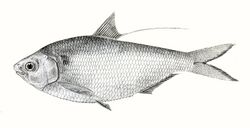Biology:Nematalosa nasus
| Nematalosa nasus | |
|---|---|

| |
| Scientific classification | |
| Domain: | Eukaryota |
| Kingdom: | Animalia |
| Phylum: | Chordata |
| Class: | Actinopterygii |
| Order: | Clupeiformes |
| Family: | Dorosomatidae |
| Genus: | Nematalosa |
| Species: | N. nasus
|
| Binomial name | |
| Nematalosa nasus (Bloch, 1795)
| |
| Synonyms | |
| |
The Bloch's gizzard shad (Nematalosa nasus), also known as gizzard shad, hairback, long-finned gizzard shad, long-ray bony bream and thread-finned gizzard shad, are a widespread and common, small to medium-sized anadromous fish found in all marine, freshwater and brackish waters throughout Indo-West Pacific, towards eastward of Andaman Sea, South China Sea and the Philippines to Korean peninsula. Single specimen recorded from waters of South Africa .[2] It was described by Marcus Elieser Bloch in 1795.
The sardines are known to swim at a maximum depth of 30 metres. The largest known standard length for the species is 22 cm.[2] The fish can separate from its sister species by the presence of a dark spot behind gill opening. Belly consists with 17 to 20and 9 to 13 scutes. It has 15 to 19 dorsal soft rays and 17 to 26 anal dorsal soft rays. It is a filter feeder and feeds on planktons. Widely used as a food fish, it can make in to fish balls and can eat both as fresh and dried forms.[2]
See also
- Commercial fish of Sri Lanka
References
External links
- Escualosa thoracata at ITIS
- Escualosa thoracata at WoRMS
Wikidata ☰ Q3072868 entry


